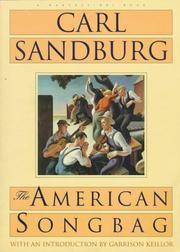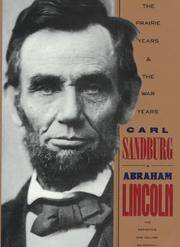He was born in Galesburg, Illinois to Swedish parents and died in Flat Rock, North Carolina.
H. L. Mencken called
Carl Sandburg "indubitably an American in every pulse-beat." He was a successful journalist, poet, historian, biographer, and autobiographer. During the course of his career, Sandburg won two Pulitzer Prizes, one for his biography of
Abraham Lincoln and the other for
The Complete Poems Of Carl Sandburg.
Much of his poetry, such as "Chicago", focused on Chicago, Illinois, where he spent time as a reporter for the Chicago Daily News and the Day Book. His most famous description of the city is as "Hog Butcher for the World/Tool Maker, Stacker of Wheat/Player with Railroads and the Nation's Freight Handler,/Stormy, Husky, Brawling, City of the Big Shoulders."
During the Spanish-American War, Sandburg enlisted in the 6th Illinois Infantry, and he participated in the landing at Guanica on July 25, 1898, during the invasion of Puerto Rico. Following a brief (two-week) career as a student at West Point with Douglas MacArthur, Sandburg chose to attend Lombard College. Sandburg left college without a degree in 1902 and married Lilian Steichen, sister of the famed photographer, Edward Steichen, in 1908. Lilian and Carl had three daughters. From 1912 to 1928, he lived in Chicago, nearby Evanston and Elmhurst. During this time he began work on his series of biographies on Abraham Lincoln, which would eventually earn him his Pulitzer Prize in history.
Sandburg lived for a brief period in Milwaukee, Wisconsin, working as a secretary to Mayor Emil Seidel, the first socialist mayor in the United States, before moving to Harbert, Michigan. It was also during his years in the Chicago area and Milwaukee that Sandburg was a member of the Social Democratic Party and took a strong interest in the socialist community. In 1945, the Sandburg family moved from the Midwest, where they'd spent most of their lives, to the Connemara estate, in Flat Rock, North Carolina. Connemara was ideal for the family, as it gave Mr. Sandburg an entire mountain top to roam and enough solitude for him to write. It also provided Mrs. Sandburg over 30 acres of pasture to raise and graze her prize-winning dairy goats.
He is also beloved by generations of children for his
Rootabaga Stories and
Rootabaga Pigeons, a series of whimsical, sometimes melancholy stories he originally created for his own daughters. The Rootabaga Stories were born of Sandburg's desire for "American fairy tales" to match American childhood. He felt that the European stories involving royalty and knights were inappropriate, and so populated his stories with skyscrapers, trains, corn fairies, and the "Five Marrrrvelous Pretzels".
His home of 22 years in Flat Rock, Henderson County, North Carolina is preserved by the National Park Service as the Carl Sandburg Home National Historic Site. Carl Sandburg College is located in Sandburg's birthplace of Galesburg, Illinois. The Rare Book and Manuscript Library at the University of Illinois Urbana-Champaign possesses the Carl Sandburg collection and archives. The bulk of the collection was purchased directly from Carl Sandburg and his family, with many smaller collections having been donated by his family and purchased from outside sources.































